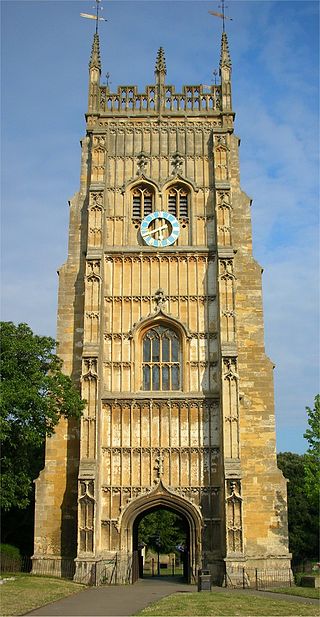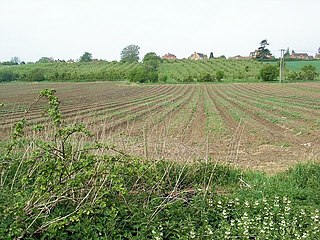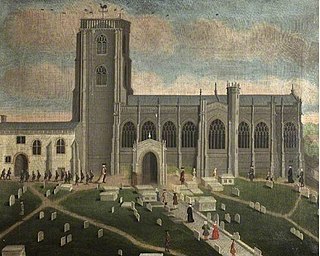
Evesham is a market town and parish in the Wychavon district of Worcestershire, in the West Midlands region of England. It is located roughly equidistant between Worcester, Cheltenham and Stratford-upon-Avon. It lies within the Vale of Evesham, an area comprising the flood plain of the River Avon, which has been renowned for market gardening. The town centre, situated within a meander of the river, is subjected regularly to flooding. The 2007 floods were the most severe in recorded history.

Evesham Abbey was founded by Saint Egwin at Evesham in Worcestershire, England between 700 and 710 following an alleged vision of the Virgin Mary by a swineherd by the name of Eof.

Reading School is a state grammar school for boys with academy status in the English town of Reading, the county of Berkshire. It traces its history back to the school of Reading Abbey and is, thus, one of the oldest schools in England, although it closed for a few years in the 1860s. It is a state boarding school. There are no tuition fees for day pupils, and boarders only pay for food and lodging. Reading is one of the best state schools in the UK according to the GCSE and A-level tables and has consistently ranked in the top ten.

St. Bartholomew's School has been a non-selective local comprehensive school since 1975. It is a co-educational state funded academy school whose predecessor schools were founded in 1466 in Newbury, Berkshire in the United Kingdom. It accepts students aged 11–18 within its local geographical catchment area, and has approximately 1,970 students on roll, including a sixth form of around 620. It is currently rated by Ofsted as "Outstanding".

The Chase School is a secondary school in Malvern, Worcestershire, England. The school opened as a Secondary Modern in 1953 under headteacher Mr Garth. It was officially opened by Lord Cobham on 26 March 1955. The Chase became a comprehensive with the abolition of selective education in Worcestershire in 1974 and became an academy on 1 November 2011. Teaching students from Year 7 to Year 13, The Chase has around 1,300 students, making it one of the larger schools in Worcestershire, with just under 300 students in the sixth form.

Spalding Grammar School (SGS), fully known as The Queen Elizabeth Royal Free Grammar School Spalding, is an 11–18 boys' grammar school in Spalding, Lincolnshire, England. By November 2015, a total of 985 boys were enrolled at the school, 277 of which were enrolled on 16 to 19 study programmes.

Harrogate Grammar School is a co-educational academy school and sixth form in Harrogate, North Yorkshire, England. It has around 1,900 pupils in the main school. A 2022 Ofsted inspection rated the school as 'Outstanding' in all five areas of the Ofsted framework

Ermysted's Grammar School is an 11-18 boys' voluntary aided grammar school in Skipton, North Yorkshire, England.

Hutton Grammar School is an 11–18 boys voluntary aided, state-funded Church of England comprehensive day school. It is located 3 miles (4.8 km) south west of Preston, Lancashire, in Hutton, England. It provides education for boys from the age of 11 to 16, and in the Sixth Form for both boys and girls.

Prince Henry's Grammar School, also known as Prince Henry's or PHGS, is a secondary school and sixth form established in 1607 in the market town of Otley, West Yorkshire, England. The school teaches boys and girls between the ages of 11 and 18 and has around 1,400 pupils and 84 teachers. It retains a high position within regional league tables. In 2016, Prince Henry's had the third highest results for GCSEs in Leeds. Also in 2016, PHGS was the best state school in Leeds for A Level results. The school has repeatedly received a 'good' rating from Ofsted with outstanding features, however has in the past received criticism for the state of the old school building. Despite the name, Prince Henry's is now a state-funded academy school.

Harvington is a village near Evesham in Worcestershire, England. Bounded by the River Avon to the south and the Lench Hills to the north, three miles northeast of Evesham and now on the Worcestershire/Warwickshire border. The village today is an amalgamation of two smaller villages, Harvington and Harvington Cross, and has a population of around 1,750.
Kenilworth School and Sixth Form, also known as Kenilworth School and Sports College, is a coeducational secondary school and sixth form based in Glasshouse Lane, Kenilworth, Warwickshire, England.
Trinity High School and Sixth Form Centre is a 13-18 co-educational academy school located in central Redditch, Worcestershire, England.

Bengeworth is a locality adjoining Evesham in Worcestershire, England. In 1887 it had a population of 1,311. Today it has a school and an Anglican church.
Bridgnorth Endowed School is a coeducational secondary school with academy status, located in the market town of Bridgnorth in the rural county of Shropshire, England. Founded in 1503, The Endowed School is a state school and is a specialist Technology College. The age range of the school is 11–18 years. It was previously known as the Bridgnorth Grammar School, and the school celebrated the 500th anniversary of its foundation in 2003. Former pupils include Professor Peter Bullock, the inspirational soil scientist who was a member of the Intergovernmental Panel on Climate Change (IPCC).

Greenhill is a hill just north of Evesham, Worcestershire and was part of the site of the Battle of Evesham. In the battle, Simon de Montfort was defeated and killed on 4 August 1265. King Henry's son, Prince Edward, later Edward I used it as his base in the battle from where he launched his attack on Simon de Montfort's forces which were gathered around Evesham Abbey.
Hanley Castle High School is a non-selective mixed secondary school and sixth form centre located in the village of Hanley Castle, 1.4 miles (2.2 km) from the small town of Upton-upon-Severn, Worcestershire. It was formerly known as Hanley Castle Grammar School, and was probably founded in 1326, making it one of the oldest schools in England.

Appleby Grammar School is a mixed secondary school and sixth form in Appleby-in-Westmorland for students aged 11 to 18. Since 2011, it has been an Academy. Until 2013, the school was a registered charity.
This article details a number of defunct schools that were once located in the Metropolitan Borough of Dudley. For details of currently operating schools in the area, please see: List of schools in Dudley.

Yeovil Grammar School was a grammar school in Yeovil, Somerset, which was founded or refounded about 1860 and closed in 1906 when its only headmaster, Henry Monk, retired.
















